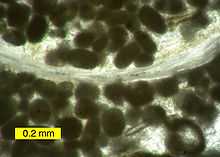Pellets (petrology)

Pellets are small spherical to ovoid or rod-shaped grains that are common component of many limestones. They are typically 0.03 to 0.3 mm long and composed of carbonate mud (micrite). Their most common size is 0.04 to 0.08 mm. Pellets typically lack any internal structure and are remarkably uniform in size and shape in any single limestone sample. They consist either of aggregated carbonate mud, precipitated calcium carbonate, or a mixture of both. They either are or were composed either of aragonite, calcite, or a mixture of both. Also, pellets composed of either glauconite or phosphorite are common in marine sedimentary rocks. Pellets and occur in Precambrian through Phanerozoic strata. They are an important component mainly in Phanerozoic strata. The consensus among sedimentologists and petrographers is that pellets are the fecal products of invertebrate organisms because of their constant size, shape, and extra-high content of organic matter.[1][2][3]
Pellets differ from oolites and intraclasts, which are also found in limestones. They differ oolites in that pellets lack the radial or concentric structures that characterize oolites. They differ from intraclasts in that pellets lack the complex internal structure, which is typical of intraclasts. In addition, pellets, quite unlike intraclasts, are characterized by a remarkable uniformity of shape, extremely good sorting, and small size.[1][2]
References
- ↑ 1.0 1.1 Folk, R.L. (1959) Practical petrographic classification of limestones. American Association of Petroleum Geologists Bulletin. 43, pp. 1-38.
- ↑ 2.0 2.1 Folk, R.L., 1962, Spectral subdivision of limestone types. . In Ham, W. E.. Classification of carbonate rocks. American Association of Petroleum Geologists Memoir. no. 1, pp. 62-84.
- ↑ Scholle, P.A., and D.S. Ulmer-Scholle (2003) A Color Guide to the Petrography of Carbonate Rocks: Grains, textures, porosity, diagenesis. American Association of Petroleum Geologists Memoir no. 77. Tulsa, Oklahoma, American Association of Petroleum Geologists. 474 pp. ISBN 0-89181-358-6